Attempts to test extinction hypotheses typically focus on a handful of key variables. Which species suffered extinction, which survived, and was there a detectable and dramatic increase in extinction rate in the Quaternary? What is the relative timing of initial human colonization, climatic/ecological change, and the major wave of extinctions? Also, what is the archaeological evidence for hunting of extinct fauna? When viewed from a global perspective, Quaternary extinctions show a number of patterns that provide clues to cause(s): (1) Extinctions were asynchronous across the globe, but globally appear to correlate to some degree with first human arrival to regions (Figure 2). (2) Quaternary extinctions on continents and large islands disproportionately and severely impacted large-bodied taxa. (Figure 5). (3) Fauna in some regions were more severely impacted than others (Figures 5 and 6). (4) In most regions, archaeological evidence for the interaction of humans and extinct animals is limited. The extinction records in various regions of the world are discussed in the following sections.
Africa
Africa holds a unique position in the Quaternary extinctions because it is the homeland of hominid and modern human evolution (see Modern Humans, Emergence of). In addition, a greater proportion of large-bodied mammalian taxa survived here than in any other region of the world (Figure 6). Proponents of overkill do not see these two facts as independent. Large mammal survival in Africa, they would argue results from the co-evolution of African large mammals with bipedal hominids whose hunting prowess gradually increased over time. Although many genera of large-bodied mammals did suffer extinction in Africa, extinctions do not show clear clustering in time, and many extinct genera were replaced by similar taxa, indicating that many African extinctions likely were caused by interspecific competition rather than anthropogenic factors.
The first members of the genus Homo evolved in Africa roughly 2.5 million years ago. However, it
Surviving
Extinct
North America
0
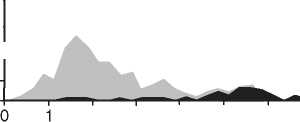
Australia
South America
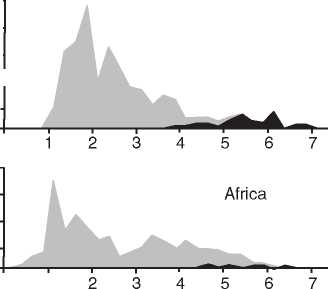
Log body mass (g)
Figure 5 Body size distributions for extinct and extant Quaternary species in North America, South America, Australia, and Africa. In all regions, extinctions were highly selective, disproportionately affecting large-bodied animals. Redrafted from Figure 1 of Lyons SK, Smith FA, and Brown JH (2004) Of mice, mastodons and men: Human mediated extinctions on four continents. Evolutionary Ecology Research 6: 339-358.
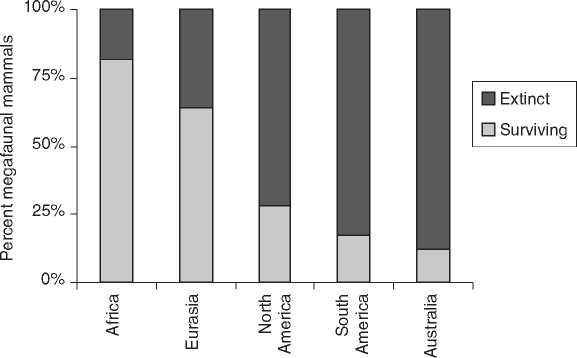
Continent
Figure 6 The percentage of extinct and extant megafaunal (>44 kg) mammalian genera by continent. Data from Barnosky AD, Koch PL, Feranec RS, Wing SL, and Shabel AB (2004) Assessing the causes of Late Pleistocene extinctions on continents. Science 306: 70-75.
Is not until the evolution of Homo erectus roughly 1.8 million years ago or perhaps even hundreds of thousands of years later that hominids had likely developed the ability to effectively hunt large animals. Over this period, there is an absence of clear temporal clustering in animal extinction in Africa, although there are many cases of likely climactically driven local extinctions (species survived in other parts of the continent). The inability to detect waves of extinction in Africa may be attributed either to a true lack of clustering of extinctions in time, or to poor chronological control on extinction events. Among the extinct Quaternary fauna of the African continent are many species of hominids including the entire genus Australopithecus, three genera of proboscideans, and more than 24 genera of ungulates and carnivores. Notably, many extinct genera have been recovered from archaeological contexts, particularly in Early and Middle Pleistocene contexts, but establishing predation of extinction species by pre-modern hominids has proved to be exceptionally difficult.
Eurasia
Like Africa, Eurasia suffered relatively few losses of large mammals, and hominids and extinct fauna coexisted for an extended period of time. The Eurasian landmass lost two genera of proboscideans including mammoths, at least three species of rhinoceros, hyenas, cave bears, hippopotamus, giant deer, and others. Europe lost proportionately more large mammals than Asia where mega-herbivores, like Asian elephants and rhinoceroses, survived to the present in tropical Southeast Asia. Unlike Africa, which sustained a hominid presence across most of the continent throughout the Pleistocene, large portions of high-latitude Eurasia remained uncolonized by Homo until the Late Pleistocene, providing refuge for many now-extinct taxa until the end of the last Ice Age. During the Pleistocene, continental glaciers expanded and contracted over most of northern Europe many times causing dramatic ecological shifts (see Paleoenvironmental Reconstruction, Methods). Hominids and animals underwent repeated range shifts in response to glacial oscillations.
The genus Homo first migrated out of Africa and into the southerly latitudes of Eurasia approximately 1.8 million years ago, or slightly earlier. It is unclear whether hominids maintained a consistent presence in Eurasia during the Early Pleistocene (1.8-0.78 million years ago), but by the start of the Middle Pleistocene c. 0.78 million years ago, Homo was likely to stay in Eurasia. By 50 000-45 000 years ago, modern Homo sapiens had spread through most of Eurasia. Precise extinction dates for many Eurasian species are poorly known, especially for Asian species and those species which suffered extinction prior to 50 000 years ago, but numerous now-extinct animals coexisted with hominids for hundreds of thousands of years before suffering extinction. Although numerous mammalian extinctions occurred throughout the Quaternary in Europe, extinction rates among large mammals increased substantially in the Late Pleistocene between c. 50 000 and 10 000 years ago with extinctions possibly occurring in two pulses.
Straight-tusked elephant and hippopotamus, species common in temperate fossil assemblages, were the first to suffer extinction, around 50 000-40 000 years ago. At this time, not only were continental glaciers Expanding pushing these species southward, but modern humans made their first incursions into Europe. Arctic species like woolly rhinoceros and mammoth, well adapted to cold glacial conditions survived through the Last Glacial Maximum (c. 20 000 years ago) only to suffer extinction as the climate warmed c. 10 000 years ago. It is also after the Last Glacial Maximum that major human influxes into arctic regions occurred. A case can be made of overkill and/or climate change as the extinction causes for Europe since extinctions seem to occur at times when both humans and climate are on the move. Now-extinct mammal species did survive into the Holocene in isolated geographic pockets. For example, dwarfed mammoths survived until 4000 years ago on Wrangell Island in high arctic northeast Asia, and the giant deer, Megaloceros survived into the Early Holocene in western Siberia and the Ural mountains.
Although human associations with extinct fauna, like rhinoceros, elephant, and mammoth, are fairly common in Lower and Middle Palaeolithic assemblages, direct associations are considerably less common in the Upper Palaeolithic when the majority of extinctions occurred. There are more than a dozen archaeological sites showing subsistence use of proboscideans (Elephas and Mammuthus) throughout Eurasia spanning more than 600 000 years of prehistory. These sites gradually increase in latitude with age, possibly reflecting slow human northward range expansion with concomitant proboscidean range contraction. Nonetheless, the causes of Eurasian mammalian extinctions remain as unresolved as on any continent.
Australia
During glacial phases of climate, sea levels dropped, and the map of Australia was dramatically altered because the island continent became connected to the adjacent islands of Papua New Guinea and Tasmania, forming the Ice Age continent of Sahul (see Oceania: Australia). Prior to human colonization, Australia was home to 28 genera and 55 species of vertebrate fauna that are now extinct (Figure 7). Australian extinctions were among the most severe of any continent, having lost 88% of its megafaunal mammalian genera (Figure 6). The largest known marsupials, the diprotodonts, large browers weighing perhaps up to 2000 kg, suffered extinction during the Late Pleistocene, as did 24 species of macropods (a family of marsupials which includes the kangaroos, tree kangaroos, wallabies, and padmelons). Also lost were a handful of carnivores including Megalania prisca, a huge meat-eating lizard. The flightless Genyornis newtoni was the largest of the five or six birds to have suffered extinction. Genyornis left
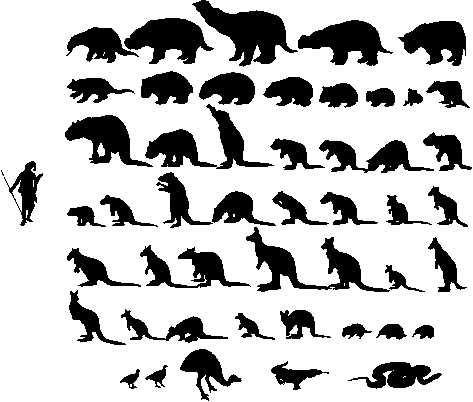
Figure 7 Silhouettes of the extinct Pleistocene fauna of Australia drawn to scale. Reproduced from Murray in P. Martin and R. G. Klein (1984) (eds.) Quaternary Extinction: A Prehistoric Revolution Tucson: University of Arizona Press.
Abundant eggshells in Australia’s fossil record that can be readily dated and analyzed to determine the animal’s diet. Studies of Genyornis eggshells have produced critical data about timing of extinction and ecological change in Australia.
Gifford Miller and colleagues dated more than 700 Genyornis eggshell fragments by the radiocarbon and amino acid racemization methods and found that the giant flightless bird went extinct between 55 000 and 45 000 years ago. The extinction date for Genyornis is unique because it is one of only very few extinct taxa whose extinction date is well established. Determining the precise timing of Australian extinctions has proved problematic. In some critical localities, it appears that extinct fauna were geologically redeposited into younger contexts creating the appearance of survival into time periods long after which the animals suffered extinction. Also, it is increasingly apparent that most Australian extinctions occurred near the temporal limit of radiocarbon dating (c. 50 000 years ago). One rigorous study of extinction dates in Australia by Richard Roberts and colleagues found that at least six genera of megafauna, in addition to Genyornis, suffered extinction at approximately 46 000 years ago. Therefore, the time period between 55 000 and 45 000 years ago appears to be the key to solving the riddle of Australian extinctions.
Although the precise date of human colonization of Australia remains controversial, well-dated contexts at Lake Mungo and Devil’s Lair both suggest a colonization date between 50 000 and 45 000 years ago. At other more controversial sites, colonization
Dates have been proposed in excess of 60 000 and even 100 000 years ago. Bearing in mind the possibility for older sites, as Australian researchers have done more work and improved dating of critical localities, dates for extinctions and human arrival seem to be converging at a 10 000 year period between 55 000 and 45 000 years ago. To many researchers, this is strong albeit circumstantial evidence for human involvement in animal extinctions.
Of course, temporal correlation is not necessarily causation, and it remains possible that climate change could have played a major or minor role in Australian extinctions. However, the climate change argument does not fare well in Australia because this critical time period, 55 000 to 45 000 years ago, was not a period of dramatic climatic shift in Australia. However, a recent study of the prehistoric diets of Genyor-nis, emus, and wombats found that when Genyornis went extinct, the diets of surviving emus and wombats shifted suddenly and permanently in multiple regions of Australia. To Gifford Miller and colleagues, this dietary shift indicates a major reorganization of Australian ecosystems right at the time of extinction, and they argue that this ecological change cannot be explained by climatic forcing. Instead, they hypothesize that burning of Australian environments by humans caused this environmental change, thus driving Genyornis and other species to extinction. Others have suggested that maybe it was not the ecological change that caused the extinction, but it was the extinction that caused the ecological change. Australia lost many species of large browsing marsupials, and their removal could have had dramatic ecological consequences as Owen-Smith has proposed for the keystone herbivore hypothesis. Though the precise cause remains unclear, many researchers are convinced of a human involvement in Australian Pleistocene extinctions. Not helping the overkill case in Australia, there are no kill sites of extinct Pleistocene fauna, and direct evidence of human use of megafauna is extremely rare.
The Americas
Extinctions in North and South America were similar to those in Australia, except they occurred 30 000 years later. In North America, 33 genera of megafauna were lost including, mammoths, mastodons, horses, camels, ground sloths, lions, cheetahs, dire wolves, giant shortfaced bears, and others. In South America, extinctions were more severe, where 50 genera of large mammals disappeared in the Late Pleistocene. These include four genera of proboscideans, three genera of horses, the great majority of large ungulates, and many genera of ground sloths and giant armadillos. Extinctions in North and South America disproportionately impacted the largest mammals, and a clear spike in extinction rates occurred in the latest Pleistocene.
Though New World Pleistocene extinctions are better dated than those in Australia, the precise timing of extinctions continues to be a matter of contention. Chronological control on North American extinctions is better than that for South America, but extinctions on both continents appear to have been more or less simultaneous occurring in a narrow time interval between c. 13 300 and 12 500 years ago. Extinctions in North and South America correlate in time with both initial human colonization and a period of dramatic climate change, the most recent transition from glacial to interglacial climate. The best-dated New World extinctions correlate well with the start of Younger Dryas stadial (c. 12 900-11500 years ago), a 1300-1400 year long abrupt reversal to glacial conditions where global temperatures cooled and glaciers readvanced (Figure 8). Humans entered the New World from northeast Asia across the Bering land bridge in the millennia preceding the Younger Dryas. For more than six decades, it was believed that the initial colonization of the New World was represented by the Clovis complex characterized by the production of lanceolate basally intended, fluted projectile points. Correlating very well New World extinctions, the Clovis complex dates to a very narrow time interval from c. 13 400 to 12 800 years ago. Recently, however, a handful of sites that appear to predate Clovis have been excavated, most notably Monte Verde, Childe, dating to 14 800 years ago, more than 1000 years before Clovis. The significance of pre-Clovis sites for the extinctions debate is twofold. First, if these sites truly predate Clovis, Martin’s blitzkrieg simulation, which assumes colonization by Clovis, cannot be correct. Second, humans and Pleistocene fauna coexisted in the New World for a slightly longer period than previously believed. Whether the existence of pre-Clovis sites is problematic or beneficial to the general overkill hypothesis, however, is not clear because it has important implications for the archaeology of overkill.
The thorn in the side of the New World overkill hypothesis has been the paucity of archaeological evidence demonstrating the exploitation of extinct fauna. In North America, there is relatively abundant evidence for hunting of mammoth during Clovis times, and there is minimal evidence for hunting of mastodon, horse, and camel. But considering that 33 genera of large mammals suffered extinction in the Late Pleistocene of North America, the overkill hypothesis is weakened by this scarcity of evidence. However, if humans were in the New World 1000-2000 years prior to Clovis and hunted Pleistocene fauna to extinction, the Clovis period
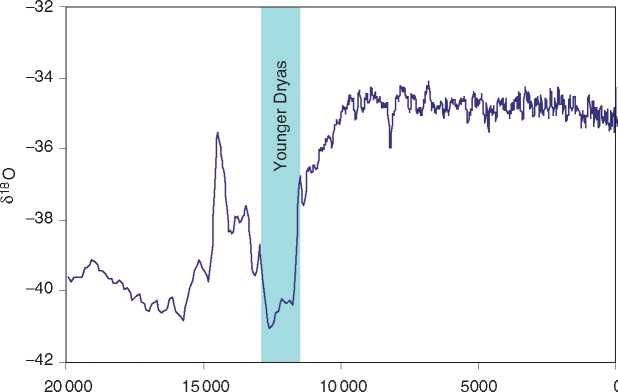
Years before present
Figure 8 The Younger Dryas stadial (highlighted in blue) recorded in stable oxygen isotopes of glacial ice in the GISP2 core from Greenland. Oxygen isotopes of glacial ice record the isotopic composition of precipitation which is strongly related to airtemperature. High values of S18O indicate warm temperatures. Low values of S18O indicate cold temperatures. The Younger Dryas was a 1400 year reversal to glacial-like conditions that punctuated the warming trend that occurred between 20000 and 10000 years ago. New World extinctions appear to correlate with the onset of the Younger Dryas. Data from Grootes PM and Stuiver M (1997) Oxygen 18/16 variability in Greenland snow and ice with 103 and 105 year time resolution. Journal of Geophysical Research 102: 26455-26470.
Correlates only with the tail end of the extinction event where many populations of extinct fauna would have been highly depressed, and the majority of hunting of extinct fauna might have occurred prior to Clovis, a portion of the archaeological record of which we have a tiny sample. Therefore, the archaeological evidence for overkill might be in the millennium just prior to Clovis, a portion of the record which has remained virtually invisible. Despite claims that the overkill hypothesis for North America has itself perished, it lives on because it remains as likely an explanation for Quaternary extinctions as any other model.
Island Extinctions
Vertebrate extinctions on oceanic islands have figured prominently in discussions of Quaternary extinctions, and unlike continental extinctions virtually all researchers agree that human impacts were responsible for the great majority of island extinctions, although precise mechanisms remain unresolved. Blitzkrieg-type overkill is advocated by some researchers, while others argue island extinctions were likely much more akin to Diamond’s sitzkrieg scenario. For overkill advocates, islands serve as important controls in the extinction debate. Many oceanic islands were not discovered or colonized by humans until well into the Holocene, and they show the survival of many genera after the extinction of their continental counterparts with extinction occurring only after human arrival. For researchers who advocate climatic/ecological hypotheses, island fauna survived because islands are insolated from climatic change, or island extinctions are irrelevant to continental extinctions because island faunas are much more vulnerable to human effects. Island animals live in small populations, within confined geographic ranges, without access to a pool of conspecifics from which to recruit new individuals.
A repeated pattern is seen on oceanic islands; with human colonization, a large range of species suffer extinction (Figure 2). Island regions that have figured prominently in extinction discussions are the West Indies, multiple Pacific archipelagos, the Galapagos, the islands of the Mediterranean, Madagascar, and New Zealand. Unlike continents, island extinctions typically impacted a broad array of vertebrate taxa including small-bodied birds, reptiles, and mammals. Among the first island extinctions were those of the Mediterranean. Early Holocene human colonization resulted in the decimation of the mammalian fauna of Mediterranean islands where only two relict Pleistocene mammalian species remain. Prior to human arrival, Mediterranean islands were home to dwarf varieties of elephants, hippos, and red deer which survived long after their nearby continental relatives; also lost were other species of ungulates, rodents, insectivores, birds, and reptiles. In the Caribbean, ground dwelling sloths, large rodents, and a wide array of small mammals, lizards, and birds suffered extinction with human colonization in the Middle Holocene. Like Mediterranean hippos and elephants, Caribbean sloths survived thousands of years after the extinction of large North and South American sloths.
The islands of New Zealand and Madagascar also show waves of extinction at the time of human colonization. Beginning around 2000 years ago, Madagascar lost many species including seven genera of giant lemurs, at least six genera of large flightless birds, a pygmy hippo, an aardvark, a large viverrine carnivore, and giant tortoises. Limited but clear archaeological evidence of human butchery of extinct giant lemurs has been recovered from Madagascar, as have a few specimens of human-modified bones of other extinct fauna, such as a tibiotarsus from the 3 m tall, 500 kg elephant bird. The islands of New Zealand were first colonized by humans only about 900-1000 years ago, but within a matter of centuries, the large flightless moas and other species were decimated. New Zealand is particularly important in the extinctions debate because clear and abundant archaeological evidence for human predation of moa species has been recovered there. More than 100 archaeological sites show evidence of human subsistence use of moas. That humans hunted and caused moa extinction is not disputed, but the relative importance of hunting, anthropogenic burning, and the introduction of non-native rats and domestic dogs in moa extinction is a matter of debate.




 World History
World History









